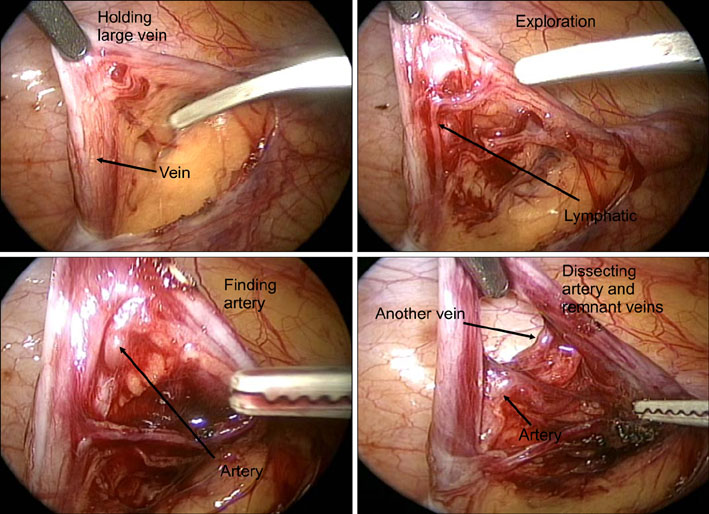Korean J Urol.
2011 Jul;52(7):489-493.
Clinical Characteristics and Surgical Outcomes in Adolescents and Adults with Varicocele
- Affiliations
-
- 1Department of Urology, Ulsan University Hospital, University of Ulsan College of Medicine, Ulsan, Korea. scpark@amc.seoul.kr
- 2Asan Medical Center, University of Ulsan College of Medicine, Seoul, Korea.
- 3School of Mechanical Engineering, Pusan National University, Busan, Korea.
Abstract
- PURPOSE
To compare clinical characteristics and surgical results in adolescents and adults with varicocele.
MATERIALS AND METHODS
We retrospectively analyzed the characteristics of 93 patients, 34 adolescents (mean age, 14.4+/-2.1 years) and 59 adults (mean age, 30.4+/-12.4 years), who underwent surgical repair of varicocele between 2006 and 2009. Median follow-up time in all patients was 18.7 months. The most bothersome symptoms, bilaterality, grades, surgical methods, artery-sparing rates, operation times, semen analysis, success rates, and recurrence-free period were compared between the two groups.
RESULTS
The overall success rate of surgical repair was 92.5%. The most bothersome symptoms were scrotal mass, pain, and hypotrophy in adolescents and pain, scrotal mass, infertility, and hypotrophy in adults (p=0.008). There were no significant between-group differences in bilaterality, grades, surgical methods, operation times, pre- or postoperative semen analyses, success rates, or recurrence-free periods. Patients who underwent artery-sparing surgery had higher recurrence rates than did those who underwent surgery that did not spare arteries. In adults, semen density increased significantly after surgery, from 35.6 million/ml to 49.6 million/ml (p=0.046).
CONCLUSIONS
There were no significant differences in clinical characteristics or surgical results between adolescents and adults with varicocele, except for the most bothersome symptoms. Semen density increased after surgery in both groups.
Keyword
MeSH Terms
Figure
Reference
-
1. Akbay E, Cayan S, Doruk E, Duce MN, Bozlu M. The prevalence of varicocele and varicocele-related testicular atrophy in Turkish children and adolescents. BJU Int. 2000. 86:490–493.2. Camoglio FS, Cervellione RM, Dipaola G, Balducci T, Giacomello L, Zanatta C, et al. Idiopathic varicocele in children. Epidemiological study and surgical approach. Minerva Urol Nefrol. 2001. 53:189–193.3. al-Abbadi K, Smadi SA. Genital abnormalities and groin hernias in elementary-school children in Aqaba: an epidemiological study. East Mediterr Health J. 2000. 6:293–298.4. Hwang Y, Park SW. Epidemiologic study of the prevalence and awareness of cryptorchidism, hydrocele, and varicocele in elementary schools in Gwangju. Korean J Urol. 2009. 50:278–281.5. Belloli G, D'Agostino S, Pesce C, Fantuz E. Varicocele in childhood and adolescence and other testicular anomalies: an epidemiological study. Pediatr Med Chir. 1993. 15:159–162.6. Pini Prato A, MacKinlay GA. Is the laparoscopic Palomo procedure for pediatric varicocele safe and effective? Nine years of unicentric experience. Surg Endosc. 2006. 20:660–664.7. Cayan S, Shavakhabov S, Kadioğlu A. Treatment of palpable varicocele in infertile men: a meta-analysis to define the best technique. J Androl. 2009. 30:33–40.8. Borruto FA, Impellizzeri P, Antonuccio P, Finocchiaro A, Scalfari G, Arena F, et al. Laparoscopic vs open varicocelectomy in children and adolescents: review of the recent literature and metaanalysis. J Pediatr Surg. 2010. 45:2464–2469.9. Abdel-Maguid AF, Othman I. Microsurgical and nonmagnified subinguinal varicocelectomy for infertile men: a comparative study. Fertil Steril. 2010. 94:2600–2603.10. Rabah DM, Adwan AA, Seida MA. Lymphatic preservation using methylene blue dye during laparoscopic varicocelectomy: early results. Can J Urol. 2009. 16:4826–4830.11. Robinson SP, Hampton LJ, Koo HP. Treatment strategy for the adolescent varicocele. Urol Clin North Am. 2010. 37:269–278.12. Cayan S, Acar D, Ulger S, Akbay E. Adolesent varicocele repair: long-term results and comparison of surgical techniques according to optical magnification use in 100 cases at a single university hospital. J Urol. 2005. 174:2003–2006.13. Dubin L, Amelar RD. Varicocele size and results of varicocelectomy in selected subfertile men with varicocele. Fertil Steril. 1970. 21:606–609.14. Lemack GE, Uzzo RG, Schlegel PN, Goldstein M. Microsurgical repair of the adolescent varicocele. J Urol. 1998. 160:179–181.15. Chehval MJ, Purcell MH. Deterioration of semen parameters over time in men with untreated varicocele: evidence of progressive testicular damage. Fertil Steril. 1992. 57:174–177.16. Lund L, Tang YC, Roebuck D, Lee KH, Liu K, Yeung CK. Testicular catch-up growth after varicocele correction in adolescents. Pediatr Surg Int. 1999. 15:234–237.17. Laven JS, Haans LC, Mali WP, te Velde ER, Wensing CJ, Eimers JM. Effects of varicocele treatment in adolescents: a randomized study. Fertil Steril. 1992. 58:756–762.18. Papanikolaou F, Chow V, Jarvi K, Fong B, Ho M, Zini A. Effect of adult microsurgical varicocelectomy on testicular volume. Urology. 2000. 56:136–139.19. Seo JW, Cho KS, Han SW. Ipsilateral testicular catch-up growth after varicocelectomy in adolescents. Korean J Urol. 2007. 48:731–734.20. Yaman O, Ozdiler E, Anafarta K, Göğüş O. Effect of microsurgical subinguinal varicocele ligation to treat pain. Urology. 2000. 55:107–108.21. Steckel J, Dicker AP, Goldstein M. Relationship between varicocele size and response to varicocelectomy. J Urol. 1993. 149:769–771.22. Maghraby HA. Laparoscopic varicocelectomy for painful varicoceles: merits and outcomes. J Endourol. 2002. 16:107–110.23. Al-Buheissi SZ, Patel HR, Wazait HD, Miller RA, Nathan S. Predictors of success in surgical ligation of painful varicocele. Urol Int. 2007. 79:33–36.24. Kim JS, Min SK, Jo MK. Effect of varicocele ligation for patients with painful varicocele. Korean J Urol. 2001. 42:732–735.25. Huk J, Fryczkowski M, Bihun M, Połać R. Laparoscopic varicocele ligation. The comparative assessment of artery-ligating and artery-preserving varicocelectomy. Wiad Lek. 2001. 54:621–631.26. Kim JM, Kim YH, Jeon YS, Kim ME, Lee NK, Park YH. Varicocele: should internal spermatic artery be ligated? Korean J Urol. 2001. 42:1195–1198.
- Full Text Links
- Actions
-
Cited
- CITED
-
- Close
- Share
- Similar articles
-
- Testicular histology and volume according to the grade in adults with varicocele
- Prevalence of Varicocele in Adolescents and Effect of Varicocele on the Testicular Volume
- Current Issues in Adolescent Varicocele: Pediatric Urological Perspectives
- The Changes of Seminal Quality after Varicocelectomy in Adolescence
- A preliminary study of shear-wave elastography for the evaluation of varicocele in adolescents and young adults


